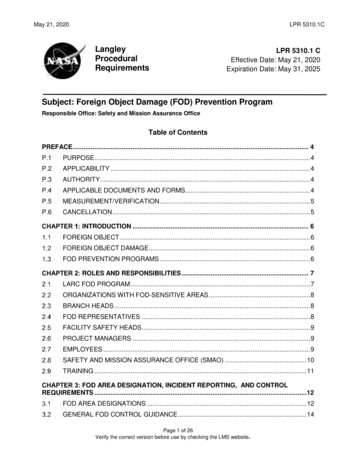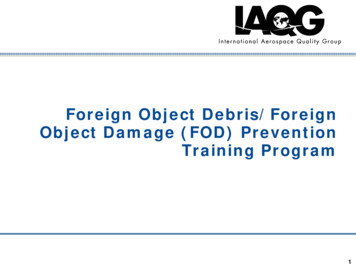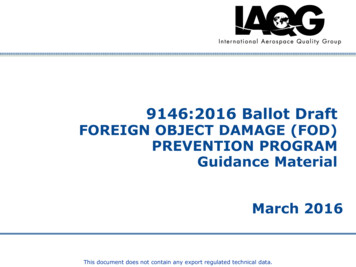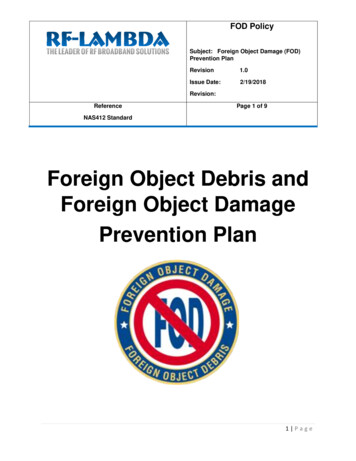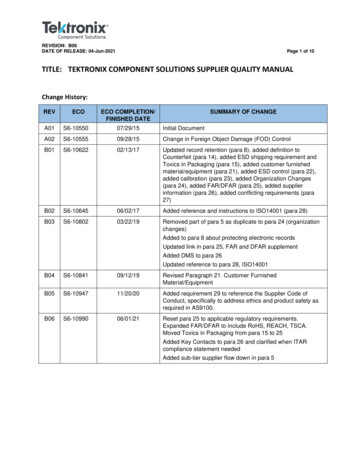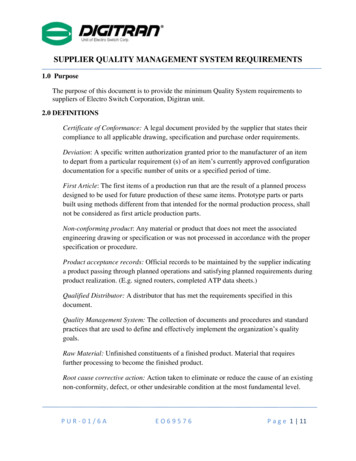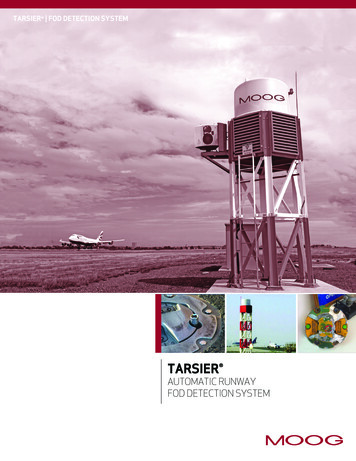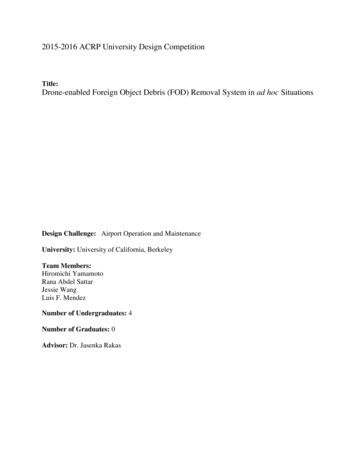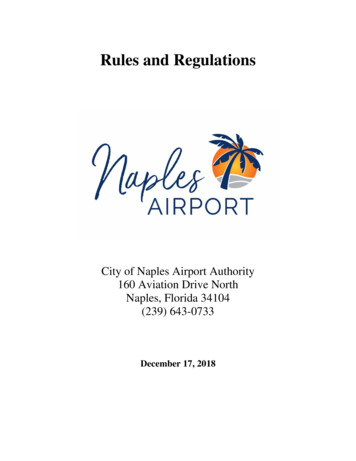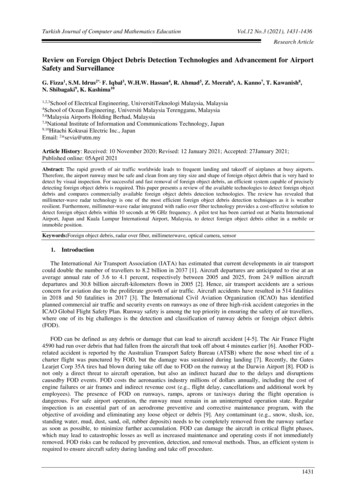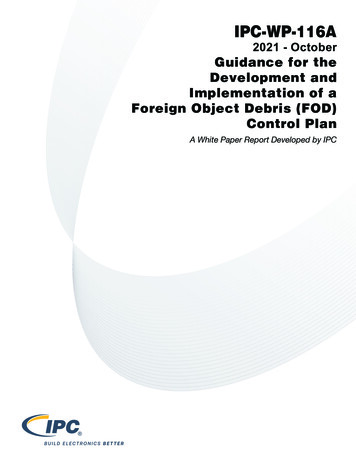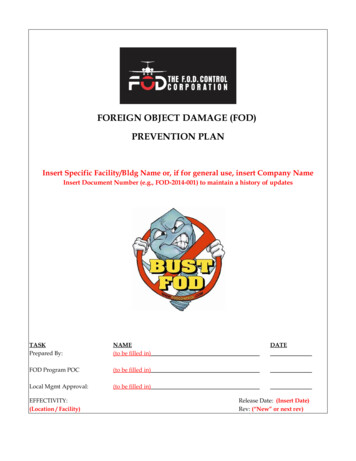
Transcription
FOREIGN OBJECT DAMAGE (FOD)PREVENTION PLANInsert Specific Facility/Bldg Name or, if for general use, insert Company NameInsert Document Number (e.g., FOD-2014-001) to maintain a history of updatesTASKPrepared By:NAME(to be filled in)FOD Program POC(to be filled in)Local Mgmt Approval:(to be filled in)EFFECTIVITY:(Location / Facility)DATERelease Date: (Insert Date)Rev: (“New” or next rev)
INSTRUCTIONS: Replace all RED text with BLACK text. Remove this statement, and any non-applicableinformation as necessary. Completed FOD Plans should be reviewed/approved by local facility management andkept in a local document repository for reference.Table of Contents2.0Scope:.43.0FOD Program Definitions / Acronyms / Terms:.44.0General Requirements:.44.1Reference Documents:.44.2FOD Prevention Training:.44.2.1Employee Requirements:.54.2.2External/Visitor Requirements:.54.3Housekeeping:.54.3.1“Clean As You Go”:.54.3.2"6S":.54.4FOD Prevention Area Identification:.64.4.1FOD Prevention Area(s).64.5Packaging, Handling, Storage & Transportation (PHST):.64.6Personal Attire and Personal Items:.64.6.14.7Designated Food/Drink Areas.7Incident Reporting:.74.7.1Incident Reporting Criteria:.74.7.2Processing Incident Reports:.74.8FOD Walk s / Walk Downs / Sweeps:.84.8.1Findings Categories:.84.9FOD Program Surveys:.84.10Records Retention Requirements:.85.05.1Additional FOD Prevention Practices:.8Equipment (Test, Support, and/or Facility) & Tooling Maintenance.8
5.2Tool Accountability & Control.95.2.1Tool Transportation.105.3Miscellaneous Small Parts (MSP) and Consumables:.105.4Accountability Checklists:.106.0FOD Program Points of Contact:.117.0Figures & Tables.127.1FOD Product Sensitive Area Signs.127.2FOD Prevention Area Map/Floor Plan.137.3Sponge Count Form.14
1.0Objective:This document details the policies and practices necessary to ensure that (insert facility/bldg/company)supports the FOD-free fabrication, assembly, test and processing of all components and products. Theplan may also outline unique FOD Program requirements requested by local management and/or thecustomer.2.0 Scope:This plan applies to (insert your building(s), facility (s) title, and/or location(s)) where Hardware and/orVehicle(s) are fabricated, assembled, transported, stored and/or tested. (update wording to reflect yourspecific environment)3.0 FOD Program Definitions / Acronyms / Terms:(Insert your own unique Definitions / Acronyms / Terms as required)FOD:(1) Foreign Object Debris.A substance, debris or article alien to a vehicle or system which would potentially cause damage.(2) Foreign Object Damage.Any damage attributed to a foreign object that can be expressed in physical or economic terms which mayor may not degrade the product’s required safety and/or performance characteristics.4.0 General Requirements:4.1 Reference Documents:The (insert company/facility name) FOD Prevention Plan is designed to address the concerns outlined inthe following documents as related to product/process integrity: NAS 412, Foreign Object Damage / Foreign Object Debris (FOD) Prevention NASA-STD-6016, Standard Materials and Processes Requirements for Spacecraft ISO-9000/9001/AS-9100 Quality Management Standard (if applicable)(Add any customer or other regional documents that might apply)4.2 FOD Prevention Training:All personnel with access to FOD Sensitive Products/Areas shall receive FOD Prevention training. Localmanagement is responsible for verifying that all employees working within affected areas/functions havecompleted the requisite training per company requirements.
4.2.14.2.2Employee Requirements:Employees of (insert company/facility name) are required to complete the following training: New Employee FOD Awareness Course – FODProgram.com (insert training requirements here)External/Visitor Requirements:Visitors and other non-(insert company name) individuals, contractors, and government agencypersonnel may be escorted within FOD Prevention Areas in lieu of training. If visitors are not escorted,then they must receive a FOD program briefing or complete the employee training. The level of trainingrequired for visitors should be at the discretion of local management.4.3 Housekeeping:Utilize normal "Clean As You Go" and "6S" routines to provide an organized and professional workingenvironment for personnel and hardware processing. FOD walks should be performed under thedirection of local management when possible.4.3.1“Clean As You Go”:"Clean As You Go" is an aerospace industry standard routine for cleaning up work areas prior to, duringand after work efforts. It is the continuous practice of debris removal and surface cleanliness duringmanufacturing, maintenance or any operation involving sensitive hardware, equipment or tools. Theroutine prevents accumulation of FOD, and thus greatly decreases the potential for FOD mitgrating into ordamaging hardware.The following are good clean-as-you-go practices, and should be applied on an everyday basis:4.3.2 Clean up the immediate and surrounding areas when work cannot continue. Clean up the area when work effort is complete. Clean up the area when departing for 15 minutes or longer. Clean up any generated debris that has the potential to migrate to an out of sight or inaccessiblearea. Clean up debris that has the potential to cause damage to hardware and/or would give theappearance of poor workmanship or housekeeping to a customer. Clean up the area before the next planned operation in support of an inspection point. Clean up the area prior to a work shift change or unplanned delay."6S":"6S" is a lean manufacturing technique that helps organize a work area to optimize efficiency. Areas setupand maintained using the 6S guidelines are less likely to generate FOD that will become entrapped orresult in product damage.The "6S" acronynm stands for:
Sort: Separating needed materials/tools/etc from unneeded Straighten: Organizing everything in its place. Places should be identified/marked. Shine: Establishing general cleanliness and cleaning routines/schedules Standardize: Maintaining and monitoring the 1st three S’s, and keeping consistency across areas Safety: Removing hazards and mistake proofing procedures Sustain: Embedding “6S” into the culture, and instilling discipline4.4 FOD Prevention Area Identification:FOD Prevention Areas must be clearly identified by signage and/or boundary markers. If required,temporary FOD Prevention Areas can be established or existing FOD Prevention Area controls and/orlevels (if applicable) may change given the approval of local management.(FOD Signs are available at FODProgram.com at discounted rates)See Figure 1 for FOD Prevention Area signage and basic definitions4.4.1FOD Prevention Area(s)The following areas within the site/facility are designated as FOD Prevention Areas:1. (insert descriptions of area(s) to be controlled and each area’s sensitivity level (ifapplicable), temporary areas need not be added to your FOD Prevention Plan)See Figure 2 for (insert company/facility name) layout/floor plan4.5 Packaging, Handling, Storage & Transportation (PHST):Inadequate or improper packaging coupled with unclean movement containers or fixtures can allow theintroduction of FOD into products during normal movement and inspection of an assembly through anarea or between areas or sites. All FOD Sensitive Product movement containers or fixtures are to becleaned in accordance with the applicable work instructions. FOD barriers such as product connectorcovers should be installed, as reasonable, on all open cavities during product moves. Products are to beadequately packaged and appropriate packing materials chosen to ensure that these materials do notmigrate into recesses or cavities within the product.4.6 Personal Attire and Personal Items:Proper working attire and control of personal items are essential to prevent the inadvertent invasion ordamage to FOD sensitive products. Personal items must be secured or removed to prevent them frombecoming FOD. Food and drink should not be allowed within the work area unless it is limited todesignated areas.4.6.1Designated Food/Drink AreasThese areas must be clearly identified with signage and/or boundary markers. The consumption of foodand drink items within the work area should be limited to this area, and items should be transported tothis area in a sealed bag/container to limit potential contamination of hardware. Locations which utilize,
store and/or dispense chemicals or hazardous materials should not be near a designated food/drink area.Local area management is responsible for identifying these areas and enforcing these requirements.4.7 Incident Reporting:Incidents involving foreign objects should be reported to local management and investigated todetermine the root cause and appropriate corrective actions. The data collected from incident reports canhelp to identify systemic issues and trends, as well as establish a baseline for expected performance.4.7.1Incident Reporting Criteria:An incident report is required when one or more of the following criteria are met:(Criteria below provided as an example – customize to your local needs) Damage to hardware or equipment is identified and confirmed to be caused by an unknownsource of FOD. FOD that is visible to the unaided eye is discovered in a FOD Sensitive Product after the operationin which it was introduced has been completed, during a time when one would expect theproduct to be FOD free. An object is lost, misplaced, or unaccounted for within a FOD Sensitive Product or Area, and is notlocated and removed before the task and any task-related close-out inspections are completed. An open hole or vacant position is discovered within a FOD Sensitive Product where an item isnormally mounted, attached, or applied. An object is found within a shipping or storage container that is foreign to the package contentsor packaging material.Note: If FOD is introduced, discovered, and removed before the operation in which it was introduced iscompleted, it is not considered an incident.4.7.2Processing Incident Reports:(Criteria below provided as an example – customize to your local needs)An initial incident report should be issued no later than 48 hours after the intial discovery of an incident.The intial report does not require cause and corrective action information, but should inform theappropriate parties that an incident has occurred.The location at which the incident was discovered should assign the task of determining root cause andcorrective actions to the area(s) they believe are responsible (may assign to themselves). The assigneeshould then conduct the investigation and report back their initial findings within 2 weeks. If additionaltime is necessary to close the investigation, it should be coordinated with the management of the findinglocation. The information from the incident report should be entered into the Organizational FODDatabase within 1 month so that metrics can be generated.4.8 FOD Walk s / Walk Downs / Sweeps:A walk down is an informal activity where local personnel physically walk through a FOD Prevention Area(often side-by-side or shoulder-to-shoulder) to inspect the area cleanliness and remove loose or
unwanted items. Items are then recorded (type & amount) for use in local area metrics and disposed ofper area practice.Items collected during a FOD walk are not reported via an incident report unless otherwise dictated bylocal area management. At the conclusion of a sweep, the area manager or local FOD POC should hold ahuddle with the team to discuss the findings to identify trends or problem areas, and work out solutions.4.8.1Findings Categories:Objects found during walk downs or reported via an incident report should be categorized to assist withdata analysis. An example of FOD categories is shown below:(Types below provided as an example)Type 1:Type 2:Type 3:Type 4:Type 5:Miscellaneous Small Parts (MSP) - Nuts, bolts, washers, etc.Consumables - Cotton swabs, any type of cable tie wraps, cheese cloth, safety wire, etc.Tools - Pliers, wire cutters, mirrors, hammers, probes, etc., including broken parts of toolsPersonal Items - Pins, pens, badges, glasses, rings, folders, clothing, etc.General Debris - any scraps and/or pieces of cloth, metal (including shavings), plastics, paper, etc.Categorization of FOD types can help to identify trends and aid in the development of FOD preventionprocesses.4.9 FOD Program Surveys:It is the responsibility of local management to monitor the health of their FOD Prevention Program, andmake adjustments and/or changes to continually improve FOD prevention practices and the program’seffectiveness. Informal audits, or surveys, should be conducted regularly (minimum annually) to ensurearea practices are compliant with the applicable FOD Prevention Plan and/or company requirements.4.10 Records Retention Requirements:Incident reports, walk-down findings, surveys and other data should be retained for a period of time inaccordance with company procedures or at the discretion of local management.(Use this section to describe the records retention policy or policies that you wish to apply to thedata collected on behalf of your FOD Program)5.0 Additional FOD Prevention Practices:5.1 Equipment (Test, Support, and/or Facility) & Tooling Maintenance(Criteria below provided as an example – customize to your local needs)All equipment used in the processing of FOD Sensitive Products, including test equipment, facility items(e.g., cranes), shop aids, tooling, fixtures, and support equipment (e.g., slings, turnbuckles), must bethoroughly inspected to ensure they are in proper working condition, and that no foreign object canmigrate and/or damage the hardware. Maintenance of equipment shall be performed as required as topreclude the risk of FOD incidents.
Note: Overhead cranes may require the use of a debris shield of drip pan to protect hardware from fluidsand particulate that may precipitate as part of normal crane operations.5.2 Tool Accountability & Control(Criteria below provided as an example – customize to your local needs)Tools in FOD Prevention Areas should be traceable to their owner and/or their storage locations. Toolaccountability/control systems may vary throughout a facility as influenced by usage and arearequirements.Note: Not all products/areas require a tool accountability/control system. Local management shoulddecide which method(s) are most appropriate based on the standard work performed in the area.Some examples and descriptions of tool accountability/control systems are listed below for reference: Etching – A tool accountability system whereby the tool is engraved, leaving a permanent mark ordesign. Serial numbers, barcodes, or other marks can be etched into the tool so that it can beidentified as belonging to a specific location or tool box. Laser etching is the preferred method, asvibro etching, especially when applied with a stylus, may result in the generation of FO and isgenerally less legible. Color coding – A tool accountability system in which a color scheme is used to identify where atool belongs. This is most often utilized when identifying tools that belong to a specific kit ortoolbox. Colors are usually apparent on the tool handle or have been attached to the tool in theform of a tag or adhesive. Tool Chits – A tool accountability system in which tool users are assigned tokens, or “chits”, thatmust be physically left in place of the tool when it is removed from storage. The tool chit oftenhas the borrower’s name, identification number, and/or picture on it. Contents Inventory Sheet –A basic tool accountability system whereby a list of all items keptwithin a storage location are recorded. The list may include details such as make, model number,quantity, etc At the end of a specified time period, the items physically remaining in the storagelocation will be compared to the contents inventory sheet to determine if any items are missing. Tool check-out / check-in sheet – A basic tool accountability system whereby a record of all toolmovements from or to a storage location are recorded. Records may include details such as whois removing/returning the tool and where/why it was used. At the end of a specified time period,the sheet should be reviewed for items that have not been returned to the storage location andare not currently accounted for. Automated Dispensing Units (ADUs) – A tool accountability system in which tools are stored in avending machine that automatically tracks the issuance/return of tools by weight, barcodescanning, or other means. ADUs are often paired with software solutions that can supply reportson tool usage, inventory levels, and more. Electronic chip encoding – A tool accountability system that uses radio frequency identification(RFID) technology to uniquely tag and identify a tool. Electronic chips are embedded or attached
to the tool that, when scanned, will provide information. This method is often paired with ADUsor other scanners to track tool usage and/or location. Shadow board / Shadow box – A tool accountability system that provides a visual reference forthe contents belonging to a storage location. Items are outlined (shadow board) or their footprintis engraved (shadow box) in a specific storage location. The footprint or outline is referred to asthe item’s shadow. This method works best when the outlines or engravings provide strong colorcontrast with the storage surfaceNote: Small tools (e.g., drill bits), which do not promote the ability to be individually identified, should bestored within a sealable container. The container can then be identified (e.g., serliazed, tagged, colorcoded) with it's respective storage location or owner, and the contents can be accounted for on aninventory sheet. When these bits are required for use, the entire container should be removed. Uponchecking the container back in, the employee or tool crib attendant should verify that all contents listedon the inventory sheet are inside.5.2.1Tool TransportationTools that are transported in portable tool containers or brought from one area to another should betracked using a check-in/check-out sheet. The sheet should identify both the borrower and the intendedlocation of the tools (e.g., in portable toolbox #123 or in use at location xyz).5.3 Miscellaneous Small Parts (MSP) and Consumables:(Criteria below provided as an example – customize to your local needs)All miscellaneous small parts (MSP) and consumables that are utilized on a day to day basis, shall becontrolled, maintained and disposed of by local management direction. It is recommended that theseitems be stored and transported in sealable containers to prevent them from becoming loose items andultimately FOD. The use of kits is strongly encouraged. TREY small parts organizers are recommended forthis purpose.5.4 Accountability Checklists:(Criteria below provided as an example – customize to your local needs)Accountability checklists should be utilized when a process/procedure requires strict accountability forinstalled items or verification that processes have been completed (e.g., ensuring inspection beforeclosing a cavity, or cleaning after the removal of adhesive labels).A “sponge count” (see Figure 3) is a commonly used accountability checklist for material items. The listserves as a written record of all items that are introduced, installed, or removed from a work area. A prework huddle should be conducted to record all of the items necessary for the operation and discuss theexpected outputs. During the operation, one employee should maintain the list while other employeesperform the work and communicate what items have been installed/removed. Facility items (e.g., desks,chairs) do not need to be recorded.6.0 FOD Program Points of Contact:The following person(s) have been identified as local points of contact for (insert location / facility).
FOD Program POC: (Insert Name)o Phone: (Insert)o Pager: (Insert) Local Area Manager:(Insert Name)o Phone: (Insert)o Pager: (Insert)Add additional POCs and/or information as necessary
7.0 Figures & Tables7.1 FOD Product Sensitive Area SignsThe signs/sensitivity levels below are provided as an example. Signs are available for purchase fromFODProgram.com at a discounted rate.Figure 1
7.2 FOD Prevention Area Map/Floor Plan(Insert floor plans as required and identify FOD Prevention Areas)Figure 2
7.3 Sponge Count FormFigure 3
(1) Foreign Object Debris. A substance, debris or article alien to a vehicle or system which would potentially cause damage. (2) Foreign Object Damage. Any damage attributed to a foreign object that can be expressed in physical or economic terms which may or may not degrade the product's required safety and/or performance characteristics.
